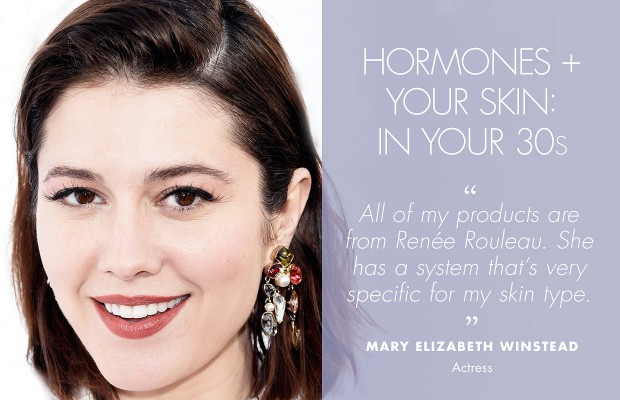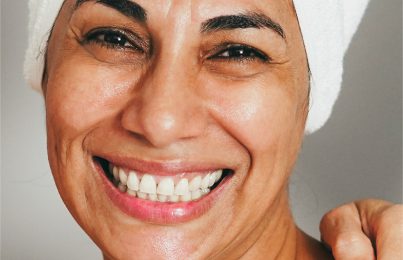Updated 7/16/24. Intrinsic aging is determined by heredity, your genetic programming that controls the hormones responsible for aging. The skin will certainly behave differently under the influences of these hormones, but how do they affect your skin and skincare in your 30s?
- How is the skin affected by hormones during the ages of 30-40?
- Complete Skincare Routine in Your 30s: 15 Essential Practices
- 1. Manage stress to reduce breakouts
- 2. Get plenty of sleep so your skin can repair properly
- 3. Keep a balanced skin care routine that focuses on healthy aging, yet won’t add excess oil
- 4. Don’t focus on what your skin did in the past. Treat it for the here and now
- 5. Use a natural skin brightener to address pregnancy-induced brown spots and melasma
- 6. Up your skincare game by using more advanced active ingredients to target your aging concerns
- 7. Choose acne spot treatments for the type of breakouts you get
- 8. Consider going on, going off or adjusting your birth control pills if breakouts are occurring often
- 9. For a deeper dive into your hormone-related concerns, consult with an endocrinologist
- 10. Wear sunscreen every single day, rain or shine
- 11. Use gentle products with salicylic acid to manage breakouts
- 12. Focus on preventing, instead of reacting to your “that time of the month” breakouts
- 13. Limit dairy in your diet if you’re prone to cystic breakouts
- 14. Limit sugary carbohydrate foods in your diet
- 15. Invest in a good eye cream and use it morning and evening
- Mastering Hormonal Changes: The Key to Healthy Skin in Your 30s
Somewhere in the early thirties (around 31-33) growth hormones slow down. The result is often little lines developing under the eyes and possibly around the mouth which can be (and should be) a wake-up call to start getting serious about caring for your skin. Stress hormones often elevate and the skin goes through another change. This is when clients come to me saying “I’m starting to get wrinkles and I’m still breaking out. Help!” As a matter of fact, many young women who never even broke out in their teens can now start in their thirties because of elevated stress levels and the hormones tied into that. Frustrating, for sure.
So now onto the good news. There are definitely actions you can take to improve all of this and prevent the visible signs of aging, I promise! It just will take some effort but now is a great time to start.
Key Hormones Affecting Skin in Your 30s
- Progesterone: Regulates sleep, immunity, and brain function.
- Estrogen: Supports collagen production, keeping skin plump and wrinkle-free.
- Testosterone: Regulates oil glands and hair growth.
- DHEA: Protects against oxidative stress, aiding in preventative skin aging.
- Human Growth Hormone: Supports skin’s elasticity and muscle tone.
How is the skin affected by hormones during the ages of 30-40?
Compared to your previous decade, there is much less activity with your sebaceous (oil) glands so your skin should be significantly less oily now. You’ll experience less red, surface pustular-type breakouts, however, adult breakouts are still alive and well. You can get cysts on the chin and jawline area that appear to come out of nowhere.
You’re now encountering the slow down of estrogen which will start to accelerate the visible signs of aging. Externally, the skin has a harder time holding onto water so the skin can feel tight really easily. You’ll start to think you need to use a heavier moisturizer to bring back a dewiness to the skin. For women who’ve never experienced pigmentation problems, you will start seeing freckles or large brown patches on the cheeks or around the mouth. Melanocytes decrease by about 10% every decade after the age of 30. That’s why skincare in your 30s is so important—there are a lot of changes happening! To maintain beautiful, healthy skin, follow these 15 tips.
Complete Skincare Routine in Your 30s: 15 Essential Practices
1. Manage stress to reduce breakouts
We know that this can be a stressful period in a woman’s life, so your skincare routine in your 30s will be a lot about managing this stree. Many of you are trying to get pregnant or already have children and/or managing a busy career outside of the home—and simply trying to be a superwoman and juggling it all. Stress not only ignites breakout activity but in general it worsens the overall skin condition by creating inflammation. How this occurs is that it induces the adrenal glands into overproduction of cortisol, a steroid, which in turn makes sebaceous glands produce more oil leading to clogged pores, bumps or blemishes. This is the reason why in stressful periods, some may experience an increase in acne by getting more of the inflamed, puss-filled type of papules rather than small whiteheads, cysts or blackheads. Regardless, finding ways to alleviate stress is always a good thing for all areas of your life. Yoga, walking, a long hot bath. Make YOU a priority. (It is now widely accepted that stress can cause almost any illness or disorder to be worse. In some cases, stress may totally trigger a biological issue.)
2. Get plenty of sleep so your skin can repair properly
From a stress management standpoint as well as a way to keep your skin in good shape, quality sleep is essential. Did you know that collagen production is accelerated during sleep? If you are consistently sleep deprived, not enough collagen is produced to replace what inflammation will naturally break down. Also, during the deepest stage of rest, growth hormones peak and stimulate cell and tissue repair.
3. Keep a balanced skin care routine that focuses on healthy aging, yet won’t add excess oil
Many in their 30s will fall into skin types #2, #4 or #6. This is when the skin can still get occasional breakouts, yet requires preventative aging benefits. Especially if you’re still experiencing oil production and breakouts, you should use moisturizers and serums that are lightweight along with a gentle, sulfate-free cleanser that will provide a deep pore cleansing without leaving the skin feeling tight and dry.
Speaking of dry, there’s a big difference between dry and dehydrated skin and you really need to know what that is.
4. Don’t focus on what your skin did in the past. Treat it for the here and now
So many people that I consult with about their skin will share all sorts of information about what their skin used to be like. While this historical information is important information for me to know so I can truly understand their skin, I find that so many people have a hard time accepting that their skin has changed, their hormones have changed and the skin simply has different needs now. (Example: breakouts are much fewer and far between than in previous years!) It’s really important that you make adjustments to your routine and not get stuck using the things that worked for your skin in your 20s or even during your teen years. Your skin truly has different needs now. Look at these nine skin types or simply take this Skin Type Quiz. It will help you learn what your skin really requires now for it to look and feel its best. Also, be careful of recommendations. Your friend may tell you about some fabulous product that he or she loves or you’ll read in a magazine about a product that a celebrity uses, but that doesn’t mean it will work for your skin.
5. Use a natural skin brightener to address pregnancy-induced brown spots and melasma
Due to the increase in hormonal activity while you are pregnant, many women can develop pigmentation. This is a very frustrating condition as patches of brown spots can appear most often above the lip, on the cheeks or forehead. The cause is hormonal changes (the increase of estrogen) which turns on melanin pigment production. What to do? For anyone who is pregnant, your best defense for preventing pigmentation is to start using a natural skin lightener every day under your sunscreen.
Recommended skin brightener: Vitamin C&E Treatment This is really important to use daily under sunscreen to fade the look of discoloration and is perfectly safe to use during pregnancy. There are many types of vitamin C (ascorbic acid, alpha lipoic acid, and l-ascorbic acid are a few examples) but I have found that magnesium ascorbyl phosphate works best for fading discoloration and it’s the one I have chosen to use in my formula.
6. Up your skincare game by using more advanced active ingredients to target your aging concerns
Read the Beginner’s Guide To Using Retinol Or Prescription Retinoids and the Beginner’s Guide To Exfoliation to learn how to get started.
7. Choose acne spot treatments for the type of breakouts you get
All breakouts are not equal nor is every blemish spot treatment. For example, if you experience deep, painful cystic bumps, applying a traditional drying spot treatment will only leave the surface of the skin a flaky, dry mess while leaving the active bump underneath. It’s so important that you understand there is a life cycle for each type of blemish.
I highly recommend that you read my step-by-step instructions for what to do the moment a blemish appears to get it to go away fast with minimal scarring. Please read it several times so you can truly understand how the natural healing process works. This information has been very insightful for my acne clients to help them learn why they are often making things much worse by using the wrong type of blemish at the incorrect stage of the healing process.
Simply put, you always want to work in sync with Mother Nature.
8. Consider going on, going off or adjusting your birth control pills if breakouts are occurring often
Without a doubt, birth control pills will affect your hormones and for some, this can improve the skin and for others, it can create problems. Read all about how birth control pills affect your skin. You can also talk to your doctor about possibly taking Spironolactone, a diuretic blood pressure treatment that’s prescribed off-label for its skin-clearing side effect in women. It doesn’t alter your hormones, but it blocks the effects of androgen on your skin which can result in fewer blemishes.
9. For a deeper dive into your hormone-related concerns, consult with an endocrinologist
This is a special kind of physician who specializes in hormonal issues. Aside from changes in your skin, it’s normal in your 30s to have other disruptions. An endocrinologist can run all sorts of tests to provide specialized help for those who have constant hormone fluctuations.
10. Wear sunscreen every single day, rain or shine
Research indicates that 78% of all sun damage incurred in a lifetime is from incidental exposure. It’s all those times when you don’t think you’re getting sun because you aren’t out there long enough to actually get a tan. Driving in the car and walking down the street on a cloudy day is still very damaging to your skin.
Just because you don’t purposely seek out a tan doesn’t mean you’re not getting the sun’s harmful rays. On days that are spent indoors, you’re still getting the damaging rays coming through windows in the form of daylight. Wear a sunscreen built into your moisturizer, applied to both your face and neck, every day, 365 days a year, rain or shine, inside or out. It’s the easiest and most effective way to slow down how quickly your skin will visibly age.
I recommend Weightless Protection SPF 30 for those in their 30s since it’s very lightweight and will not clog the pores.
11. Use gentle products with salicylic acid to manage breakouts
Since most people in their 30s aren’t dealing with daily breakouts, but rather just occasional ones, you don’t want to be using products that are overly drying and you don’t want every product in your routine to be exclusively for acne when your skin has other needs, too. The best way to do this is to just use a few effective, acne-focused products and the best ingredient to look for is salicylic acid.
Salicylic acid is a keratolytic beta hydroxy acid (BHA) famous for its ability to smooth the skin without causing irritation, reduce blemish-causing bacteria and oil to prevent blemishes, all while penetrating the pores to help clear out impurities. This is also great to use for preventing blackheads after you get them manually cleaned out with a deep pore cleansing facial or if you decide to remove them yourself.
A perfect blemish-reducing cleanser is AHA/BHA Blemish Control Cleanser which utilizes salicylic acid and gentle jojoba beads to deep clean the pores. It was actually awarded “Best Cleanser for Oily Problem Skin” by Allure Magazine. Since it’s sulfate-free, it won’t dehydrate or irritate the skin. Then, depending on your skin type, use an exfoliant like Pore + Wrinkle Perfecting Serum which has 1% salicylic acid or BHA Clarifying Serum which contains 2%.
12. Focus on preventing, instead of reacting to your “that time of the month” breakouts
Easier said than done. It is still very common to get breakouts in your 30s and it’s all hormonally induced—especially if they are hard, cystic bumps that develop deep within the skin and linger for weeks. It’s important to understand that you’re fighting a losing battle if you just focus on spot treating a blemish once it appears. Preventing them is essential and with the right types of anti-bacterial, pore-clearing products, you can definitely lessen the breakout activity due to hormones. Read more about why you’re getting monthly hormonal acne and tips to prevent it.
13. Limit dairy in your diet if you’re prone to cystic breakouts
Since most dairy cows are given growth hormones, the consumption of milk, cheese and yogurt become factors that influence endogenous hormones and mimic the hormones that trigger oil production in the skin to ignite the acne process. Hard, painful cystic bumps can appear on the chin and jawline area. Consider eliminating all dairy for three weeks to determine if this is the cause of your cystic breakout activity.
14. Limit sugary carbohydrate foods in your diet
Another key aspect of preventing hormonal breakouts may have to do with what you put in your mouth. Those sugary carbs so many young women crave during their period may be the very thing causing the breakout to occur. They can cause a prolonged increase in insulin levels and increase acne. Try cutting back on the carbs, especially prior to your monthly cycle, and you may find you’ll experience fewer blemishes.
15. Invest in a good eye cream and use it morning and evening
For most, the first signs of lines and wrinkles will appear around the eye area and really starts to kick in around ages 30-32. These visible changes in their skin will generally motivate most people them to start taking better care of their skin, including using eye cream. It’s so important to treat this area of the face with much-needed moisture and firming ingredients.
Mastering Hormonal Changes: The Key to Healthy Skin in Your 30s
By understanding how hormones affect your skin in your 30s and implementing a comprehensive skincare routine, you can maintain healthy, glowing, and youthful skin. Adapt your skincare routine to your current skin needs, use products suited for your skin type, and incorporate natural skin brighteners and advanced active ingredients to address aging concerns. Maintain a balanced diet, manage stress, get adequate sleep, and consult specialists if needed. With these steps, you can effectively manage hormonal changes and achieve the best skincare in your 30s.
Read how hormones affect the skin in your teens, 20s, 40s, 50s and 60s.
Celebrity Esthetician & Skincare Expert
As an esthetician trained in cosmetic chemistry, Renée Rouleau has spent 30 years researching skin, educating her audience, and building an award-winning line of products. Her hands-on experience as an esthetician and trusted skin care expert has created a real-world solution — products that are formulated for nine different types of skin so your face will get exactly what it needs to look and feel its best. Trusted by celebrities, editors, bloggers, and skincare obsessives around the globe, her vast real-world knowledge and constant research are why Marie Claire calls her “the most passionate skin practitioner we know.”



